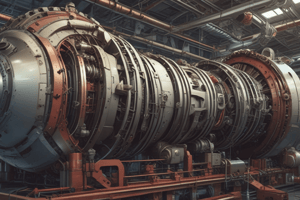Podcast
Questions and Answers
Which of the following is the common feature of material removal processes?
Which of the following is the common feature of material removal processes?
- Removal of material from a starting work part (correct)
- Addition of material to a starting work part
- Altering the color of the starting work part
- Heating the starting work part to a high temperature
Which of the following best describes machining?
Which of the following best describes machining?
- Material removal through chemical etching
- Material removal by a sharp cutting tool (correct)
- Material removal using various energy forms, without a sharp cutting tool
- Material removal by hard, abrasive particles
What is the primary characteristic of machining that makes it suitable for producing parts with specific geometric features?
What is the primary characteristic of machining that makes it suitable for producing parts with specific geometric features?
- Low precision and accuracy
- High precision and accuracy (correct)
- Limited material options
- High material waste
Which manufacturing process is generally considered less accurate than machining?
Which manufacturing process is generally considered less accurate than machining?
Which of the following is a primary reason why machining is considered important in manufacturing?
Which of the following is a primary reason why machining is considered important in manufacturing?
Which of the following is a disadvantage of machining?
Which of the following is a disadvantage of machining?
In a typical manufacturing sequence, when is machining generally performed?
In a typical manufacturing sequence, when is machining generally performed?
Which of the following is created by other processes before machining provides the final shape?
Which of the following is created by other processes before machining provides the final shape?
Which of the following describes a rotational machined part?
Which of the following describes a rotational machined part?
In machining operations, what primarily determines the part geometry in the 'generating' method?
In machining operations, what primarily determines the part geometry in the 'generating' method?
Which factor determines the part geometry, when 'forming' is used in machining operations?
Which factor determines the part geometry, when 'forming' is used in machining operations?
Which machining operation is used to remove material from a rotating workpiece to create a cylindrical shape?
Which machining operation is used to remove material from a rotating workpiece to create a cylindrical shape?
Which machine tool is primarily used to perform a turning operation?
Which machine tool is primarily used to perform a turning operation?
Facing, taper turning, and contour turning are all variations of which machining operation?
Facing, taper turning, and contour turning are all variations of which machining operation?
In the context of machining, what term describes the waste material generated during the cutting process?
In the context of machining, what term describes the waste material generated during the cutting process?
What type of force, when applied to ductile materials, allows them to be stretched into a wire?
What type of force, when applied to ductile materials, allows them to be stretched into a wire?
What characteristic defines brittle materials under a load?
What characteristic defines brittle materials under a load?
Which of the following chip types is associated with brittle work materials, low cutting speeds, and high tool-chip friction?
Which of the following chip types is associated with brittle work materials, low cutting speeds, and high tool-chip friction?
For machining ductile materials, what conditions typically produce a continuous chip?
For machining ductile materials, what conditions typically produce a continuous chip?
Which type of chip formation involves portions of the work material adhering to the rake face of the tool, leading to an undesirable cutting condition?
Which type of chip formation involves portions of the work material adhering to the rake face of the tool, leading to an undesirable cutting condition?
Under what machining circumstances are serrated chips most likely to occur?
Under what machining circumstances are serrated chips most likely to occur?
Which machining operation is most suitable when a combination of generating and forming is required?
Which machining operation is most suitable when a combination of generating and forming is required?
An engineer is attempting to machine a very hard alloy at high speeds. However, they notice excessive vibration and rapid tool wear. Which type of chip formation is MOST likely occurring, contributing to these issues?
An engineer is attempting to machine a very hard alloy at high speeds. However, they notice excessive vibration and rapid tool wear. Which type of chip formation is MOST likely occurring, contributing to these issues?
To optimize a turning operation performed on a ductile metal using a titanium-nitride-coated carbide insert, an issue arises, there is built up edge. Without changing the tool or material, what adjustment would MOST directly address the formation of a BUE?
To optimize a turning operation performed on a ductile metal using a titanium-nitride-coated carbide insert, an issue arises, there is built up edge. Without changing the tool or material, what adjustment would MOST directly address the formation of a BUE?
A machinist observes that during a turning operation, the surface finish is poor and irregular, despite using a sharp cutting tool and correct cutting parameters for a ductile material. What is the MOST probable cause?
A machinist observes that during a turning operation, the surface finish is poor and irregular, despite using a sharp cutting tool and correct cutting parameters for a ductile material. What is the MOST probable cause?
A manufacturing engineer wants to implement a machining process after casting and forging. Which single factor will determine the selection of machining for the final stages?
A manufacturing engineer wants to implement a machining process after casting and forging. Which single factor will determine the selection of machining for the final stages?
What is the most significant consideration when selecting turning as the method for machining?
What is the most significant consideration when selecting turning as the method for machining?
A shop is looking to purchase additional machines, primarily either lathes or mills. All the machined parts will be rotational. Given this piece of information, what machine tool should be purchased?
A shop is looking to purchase additional machines, primarily either lathes or mills. All the machined parts will be rotational. Given this piece of information, what machine tool should be purchased?
While a cutting operation is underway on a lathe, a continuous BUE chip is observed. Which of the options below will BEST minimize this effect while still promoting high quality output?
While a cutting operation is underway on a lathe, a continuous BUE chip is observed. Which of the options below will BEST minimize this effect while still promoting high quality output?
Flashcards
Material Removal Processes
Material Removal Processes
Shaping operations that remove material from a starting work part to achieve the desired geometry.
Machining
Machining
Material removal using a sharp cutting tool.
Abrasive processes
Abrasive processes
Material removal by hard, abrasive particles.
Nontraditional processes
Nontraditional processes
Signup and view all the flashcards
Metal parts in Machining
Metal parts in Machining
Signup and view all the flashcards
Lathe
Lathe
Signup and view all the flashcards
Generating in Machining
Generating in Machining
Signup and view all the flashcards
Forming in Machining
Forming in Machining
Signup and view all the flashcards
Cutting threads
Cutting threads
Signup and view all the flashcards
Turning
Turning
Signup and view all the flashcards
Facing (on a lathe)
Facing (on a lathe)
Signup and view all the flashcards
Taper turning
Taper turning
Signup and view all the flashcards
Contour turning
Contour turning
Signup and view all the flashcards
Wasteful of material
Wasteful of material
Signup and view all the flashcards
Time consuming
Time consuming
Signup and view all the flashcards
Machining Manufacturing
Machining Manufacturing
Signup and view all the flashcards
Rotational Components
Rotational Components
Signup and view all the flashcards
Nonrotational Components
Nonrotational Components
Signup and view all the flashcards
Chip Formation
Chip Formation
Signup and view all the flashcards
Discontinuous chip
Discontinuous chip
Signup and view all the flashcards
Continuous chip
Continuous chip
Signup and view all the flashcards
Continuous chip with Built-up Edge (BUE)
Continuous chip with Built-up Edge (BUE)
Signup and view all the flashcards
Serrated chip
Serrated chip
Signup and view all the flashcards
Ductile material
Ductile material
Signup and view all the flashcards
Brittle material
Brittle material
Signup and view all the flashcards
Study Notes
- Machining is a material removal process that shapes a workpiece by removing material from it.
Machining
- Machining utilizes a sharp cutting tool to mechanically remove material, achieving the desired geometry of the part.
- Primarily used for metal parts, this process stands out as the most versatile manufacturing method.
- It is known for producing a variety of part shapes and geometric features with high precision and accuracy.
- Casting offers shape variety, machining offers superior accuracy.
Why Machining is Important:
- Applicable to a variety of work materials, machining is frequently employed with metals.
- Enables the creation of diverse part shapes, including screw threads, accurate round holes, and very straight edges and surfaces.
- Ensures good dimensional accuracy and surface finish of the final product.
Disadvantages of Machining
- Machining can be wasteful due to the generation of chips.
- The process generally takes longer than alternative shaping.
Machining within the Manufacturing Sequence
- Typically follows basic manufacturing processes like casting, forging, and bar drawing.
- Processes like casting, forging, and bar drawing create the general shape of the starting work part.
- Provides the final shape, dimensions, finish, and special geometric details that are not attainable through the initial processes.
Classification of Machined Parts
- Rotational parts have cylindrical or disk-like shapes.
- Nonrotational parts have block-like and plate-like shapes.
Machining Operations and Part Geometry
- Relative motions between the tool and workpiece and the shape of the cutting tool are critical.
- Generating involves the part geometry being determined by the feed trajectory of the cutting tool.
- Forming involves part geometry that is created by the shape of the cutting tool.
Generating Shapes
- Straight turning, taper turning, contour turning, plain milling, and profile milling are examples of generating shapes.
Forming to Create Shape
- Form turning, drilling, and broaching are examples of forming shapes.
Forming and Generating
- Thread cutting on a lathe and slot milling, demonstrate a combination of forming and generating.
Turning
- A single point cutting tool removes material from a rotating workpiece, resulting in a cylindrical shape.
- It is performed on a machine tool called a lathe.
- Variations of the turning process include facing, contour turning, chamfering, cutoff, and threading.
Operations Related to Turning
- Facing, taper turning, and contour turning are operations related to turning.
More Operations Related to Turning
- Form turning, chamfering, and cutoff are more operations related to turning.
Further Operations Related to Turning
- Threading, boring, and drilling are also turning operations.
Engine Lathe
- An engine lathe has components of a headstock, spindle, tool post, tailstock, bed, cross slide, carriage, feed controls, speed controls, ways, and lead screw.
Actual Chip Formation
- Chip formation involves a shear zone, with a secondary shear zone resulting from tool-chip friction.
Basic Types of Chip in Machining
- There are four basic types of chips; discontinuous, continuous, continuous with built-up edge (BUE), and serrated.
Discontinuous Chip
- Brittle work materials, low cutting speeds, large feed and depth of cut, and high tool-chip friction are associated with discontinuous chips.
Continuous Chip
- Ductile work materials, high cutting speeds, small feeds and depths, a sharp cutting edge, and low tool-chip friction are associated with a continuous chip.
Continuous with BUE
- Ductile materials, low-to-medium cutting speeds, and tool-chip friction causing chip portions to adhere to the rake face are associated with continuous chips.
- The built-up edge (BUE) forms, then breaks off cyclically.
Serrated Chip
- A semi-continuous, saw-tooth appearance is shown on the chip.
- Cyclical formation with alternating high and low shear strain is observed.
- This is commonly noticed with difficult-to-machine metals at high cutting speeds.
Ductile vs Brittle Materials
- Ductile materials can be twisted with no crack and hold deformation.
- These materials can be stretched into a wire, but under compressive force, they can be deformed into sheets.
- Common ductile materials are copper, aluminum, and steel.
- Brittle materials break as opposed to bending.
- Under a load, brittle materials must twist marginally to endure.
- Brittle materials will return to their old shape with low loads, and distortion is perpetual with high loads.
- Common brittle materials are glass and ionic crystals.
Studying That Suits You
Use AI to generate personalized quizzes and flashcards to suit your learning preferences.




